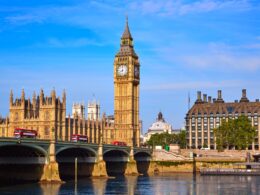Hong Kong’s Concept4 Limited, winner of Gold in Asia’s Best Sustainability Report (SME) at the 11th Asia Sustainability Reporting Awards (ASRA), is redefining how small and medium enterprises embed sustainability at their core. In an exclusive interview with ESG Post, CEO Pascal Vielvoye reflects on how the company has transformed sustainability from a compliance exercise into a catalyst for innovation, resilience, and long-term value creation. “Sustainability could once be seen as a competitive advantage,” he notes, “but today it’s an essential requirement—something no company can overlook.”
Congratulations on your company’s success at the Asia Sustainability Reporting Awards. What does this achievement signify from a leadership perspective?
Thank you for the warm congratulations—it’s a real pleasure to have our work recognised at the Asia Sustainability Reporting Awards.
From a leadership viewpoint, this win is clear evidence that the foundations we’ve established are bearing fruit. It shows we’ve effectively created an enabling structure for sustainability and followed through with the practical measures to embed our strategy. To receive such affirmation from an esteemed external body is particularly affirming, highlighting how our internal priorities—shaped by our collaborative approach and the strong efforts of our team—are gaining wider appreciation.
It’s a moment that brings genuine satisfaction, bolstering our resolve to continue.
How does sustainability fit within your overall business strategy and long-term value-creation goals?
Sustainability forms an integral part of our business strategy, underpinning both our day-to-day activities and our aims for sustained value generation. In sectors such as fashion and beauty, under constant examination yet pioneering advancements in ethical practices, we, as a committed participant, are obliged to affirm our dedication. This involves incorporating sustainability into our fundamental principles, rather than treating it as peripheral: be it through responsible sourcing, reducing production waste, promoting circular models, or supporting supply chain communities.
In the current landscape, adopting it on a worldwide scale is essential; within our organisation, it aligns our people towards a common objective that builds durability, earns stakeholder confidence, and secures lasting benefits.
By aligning our strategies with environmental boundaries, we reduce risks and uncover opportunities that build customer loyalty and open new markets.
What role do you personally play in setting and steering the sustainability agenda within the company?
I see myself as the conductor, guiding the overall direction and pace of our sustainability initiatives, while striving to integrate these values across every department. This creates a common thread that binds our teams, fostering unity. Ultimately, sustainability belongs to no single person; it is the cohesive element that draws the entire group towards a shared aim.
Many CEOs now see sustainability as a competitive advantage. How has it shaped innovation, market growth, or stakeholder trust for your organisation?
Some years ago, sustainability could be framed as a clear competitive advantage, but now it is an essential requirement—something no company can overlook, especially in the beauty and fashion industries where standards are running high. For our organisation, it has influenced our methods significantly: advancing innovation via detailed data analysis, rather than isolated reports; supporting market expansion through evidence of year-on-year advancements that attracts conscious consumers; and reinforcing stakeholder confidence with open disclosures of ongoing progress.
At its core, sustainability hinges on data. Where once it involved merely presenting figures at a single point, now it’s about rigorous analysis—tracking improvements over time to refine our strategies. The real edge comes not from sustainability alone, but from the commitments to digital systems and automation. These allow us to track supply chains continuously, streamline resource allocation, and expand initiatives effectively, transforming obligations into sources of stability and potential.
Why do you believe sustainability reporting is vital for corporate leadership today?
I regard sustainability reporting as crucial for corporate leadership today, for two principal reasons that support trust and forward planning in a landscape of growing accountability.
Firstly, it demonstrates transparency, building assurance among stakeholders from investors and regulators to customers and partners. In our line of work, where scrutiny is ever-present, this openness isn’t optional; it’s a foundation for credibility. Third-party verification adds further weight, and while a full report audit remains cost-prohibitive for us at present, we prioritise rigorous external checks on our Scope 1, 2, and 3 calculations to ensure our data stands up to examination.
Second, it offers a vital moment for reflection and assessment, allowing us to chart our evolution and consolidate achievements. By summarising what’s been accomplished, we not only celebrate progress but also identify pathways forward, equipping the organisation to anticipate challenges and seize opportunities with greater clarity.
How do you ensure that sustainability performance remains a board-level priority amid other business pressures?
Ensuring sustainability performance stays at the board level amid competing pressures is indeed one of the foremost challenges organisations face today. We’re witnessing a troubling trend of regulations being rolled back in various regions, with the spotlight increasingly on growth and profitability, pressures that can easily sideline longer-term imperatives.
Yet, this very moment presents a critical opportunity to keep sustainability central, by demonstrably linking it to robust business cases that enhance growth and competitiveness. In our view, sustainability thrives best under clear regulatory guidance, provided those rules remain straightforward and readily actionable; therein lies another avenue for progress, as simplified frameworks can accelerate adoption without undue burden.
For us, there’s no debate, sustainability is firmly entrenched as a board priority. To reinforce it further, we leverage a structured calendar of certifications and disclosures, including EcoVadis, B Corp, CDP, and our annual reporting cycle. These milestones ensure we meet every deadline while keeping the agenda vividly in mind for all involved, turning routine compliance into a steady reminder of our commitments.
Could you share an example of a major decision or investment where sustainability considerations played a decisive role?
One clear example is our investment in building a dedicated digital team to create proprietary tools and strengthen our data infrastructure. As we’ve discussed, sustainability fundamentally depends on robust data; without it, meaningful reporting and year-on-year analysis simply aren’t possible. This decision was driven directly by our sustainability goals, which have always shaped our broader digital strategy, hand in hand from the outset. Today, that digital framework extends well beyond sustainability, supporting efficiency across the business, but it began as a response to those core environmental imperatives.
As regulatory frameworks such as ISSB gain traction, how do you view their impact on Asian businesses?
I see these standardisation efforts as a welcome development. All too often, comparing reports and outcomes across companies or even sectors, proves challenging, leading to inconsistencies that undermine progress.
Fifteen years ago, we encountered a parallel issue with factory audit processes: without common standards, it bred widespread audit fatigue, overwhelming teams with redundant efforts. Today, we have the benefit of those lessons, allowing us to sidestep a similar ‘sustainability fatigue’ by building more streamlined approaches from the start.
That said, while a core global framework is invaluable, the real test comes in tailoring it to specific sectors. What suits a bank, for instance, may not align with the needs of a cosmetics trading firm. We must guard against a one-size-fits-all mentality, ensuring these standards evolve beyond mere box-ticking to drive genuine, sector-relevant action.
Looking ahead, what are your top three sustainability priorities for the next three years?
Looking ahead, our top three sustainability priorities for the next three years centre on strengthening our operations and partnerships for lasting impact.
First, advancing supplier onboarding and collaboration, extending beyond Tier 1 or 2 to include deeper ties with Tier 3 and further. This involves forging more transparent relationships across our supply chain to promote ethical sourcing and mutual objectives, mitigating risks and boosting shared advancement.
Second, refining our data sources and calculations for sharper accuracy and insights. We’ll continue investing in systems to gather more detailed, reliable metrics, particularly for Scope 3 emissions, facilitating stronger analysis and highlighting clear year-on-year gains.
Third, educating our B2B clients on product lifecycle management, with a strong emphasis on incorporating recycled materials, cutting waste, and boosting resource efficiency. Through targeted workshops and collaborative pilots, we’ll guide them in practical applications that spark innovation, transforming sustainability from a duty into a source of creative product development and market edge.
What message would you like to send to your peers and the wider business community about responsible leadership in this decisive decade for climate and sustainability?
To my fellow leaders and the broader business world: if you haven’t begun your sustainability efforts, start today, this decade is pivotal, so act with purpose. Don’t treat it as a chore; embrace it as a chance to innovate, strengthen your business, and open fresh paths to success. Your teams will embrace it too, united by a common goal that fits our shared tomorrow.
Most importantly, don’t let current geopolitical turmoil dictate your plans—ground them in timeless values of care and long-term vision. True leadership means steering steadily through uncertainty.





















